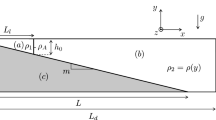Abstract
A simple numerical model demonstrates that the reduction in turbulence due to stratification greatly enhances the trapping of suspended sediment that occurs at the estuarine turbidity maximum. In moderately and highly stratified estuaries the turbulent diffusivity decreases markedly between the region upstream of the salinity intrusion, where the turbulence is uninhibited by salt stratification, and the stratified regime within the salinity intrusion, where turbulence is reduced by the inhibitory influence of salt stratification. This reduction in turbulent diffusion results in a reduction in the quantity of sediment that can be carried by the flow, causing sediment to be trapped near the landward limit of the salinity intrusion. This trapping process occurs at the same location as that due to the estuarine convergence, but it appears to be many times more effective at trapping silt-size particles. A model is formulated that is similar to Festa and Hansen's (1978) model of the estuarine turbidity maximum, with the addition of a stratification-dependent eddy diffusivity. For silt-size sediment particles, the model indicates as much as a 20-fold increase in the trapping rate with inclusion of the stratification effect. it is likely that this mechanism is important in many partially mixed and highly stratified estuaries.
Similar content being viewed by others
Literature Cited
Allen, G. P., J. C. Salomon, P. Bassoulet, Y. du Penhoat, andC. de Grandpre. 1980. Effects of tides on mixing and suspended sediment transport in macrotidal estuaries.Sedimentary Geology 26:69–90.
Allen, G. P., G. Sauzay, P. Castaing, andJ. M. Jouanneau. 1976. Transport and deposition of suspended sediment in the Gironde Estuary, France, p. 63–81.In M. Wiley (ed.), Estuarine Protesses, II. Academic Press, New York.
Dyer, K. 1986. Coastal and Estuarine Sediment Dynamics. John Wiley, New York. 342 p.
Festa, J. F. andD. V. Hansen. 1978. Turbidity maxima in partially mixed estuaries: A two-dimensional numerical model.Estuarine and Coastal Marine Science 7:347–359.
Gelfenbaum, G. 1983. Suspended-sediment response to semidiurnal and fortnightly tidal variations in a mesotidal estuary: Columbia River, U.S.A..Marine Geology 52:39–57.
Geyer, W. R. andD. M. Farmer. 1988. Tide-induced variation of the dynamics of a salt wedge estuary.Journal of Physical Oceanography 28:1060–1072.
Glangeaud, L. 1938. Transport et sédimentation dans l'estuaire et a l'embouchure de la Gironde. Caracteres Petrographiques des Formations Fluviatiles, Saumatres, Littordes, et Néritiques.Bulletin of Geological Society of France 8:599–630.
Grabemann, I. andG. Krause. 1989. Transport processes of suspended matter derived from time series in a tidal estuary.Journal of Geophysical Research 94:14,373–14,379.
Haas, L. W. 1977. The effect of the spring-neap tidal cycle on the vertical salinity structure of the James, York and Rappahannock rivers, Virginia, U.S.A.Estuarine and Coastal Marine Science 5:485–496.
Hamblin, P. F. 1989. Observations and model of sediment transport near the turbidity maximum of the upper Saint Lawrence Estuary.Journal of Geophysical Research 94:14,419–14,428.
Jay, D. A. andJ. D. Smith. 1990. Circulation, density distribution and neap-spring transitions in the Columbia River Estuary.Progress in Oceanography 25:81–112.
Kineke, G. C., R. W. Sternberg, D. A. Cacchione, K. Kranck, andD. E. Drake. 1991. Distribution and characteristics of suspended sediment on the Amazon Shelf.Oceanography 4:21–26.
Lang, G., R. Schubert, M. Markofsky, H.-U. Fanger, I. Grabemann, H. L. Krasemann, L. J. R. Newmann, andR. Riethmüller. 1989. Data interpretation and numerical modeling of the mud and suspended sediment experiment 1985.Journal of Geophysical Research 94:14,381–14,393.
Leonard, B. P. 1979. A survey of finite differences of opinion on numerical muddling of the incomprehensible defective confusion equation, p. 1–38.In T. J. R. Hughes(ed.), Finite Element Methods for Convection Dominated Flows. American Society of Mechanical Engineers, New York.
Meade, R. H. 1972. Transport and deposition of sediments in estuaries.The Geological Society of America, Inc., Memoir 133:91–120.
Mellor, G. L. andT. Yamada. 1974. A hierarchy of turbulence closure models for planetary boundary layers.Journal of Atmospheric Science 31:1791–1806.
Milliman, J. D., S. Huang-Ting, Y. Zuo-Sheng, andR. H. Meade. 1985 Transport and deposition of river sediment in the Changjiang estuary and adjacent continental shelf.Continental Shelf Research 4:37–45.
Munk, W. H. andE. R. Anderson. 1948. Notes on the theory of the thermocline.Journal of Marine Research 7:276–295.
Nittrouer, C. A., T. B. Curtin, andD. J. DeMaster. 1986. Concentration and flux of suspended sediment on the Amazon continental shelf.Continental Shelf Research 6:151–174.
Officer, C. B. 1976. Physical Oceanography of Estuaries (and Associated Coastal Waters). John Wiley and Sons, New York. 465 p.
Postma, H. 1967. Sediment transport and sedimentation in the estuarine environment, p. 158–179.In G. H. Lauff (ed.), Estuaries. American Association for the Advancement of Science, Washington, D.C.
Richardson, L. F. 1920. The supply of energy from and to atmospheric eddies.Proceedings of the Royal Society of London Series A 27:354–373.
Schubel, J. R. 1968. Turbidity maximum of the northern Chesapeake Bay.Science 161:1013–1015.
Sheng, Y. P. andC. Villaret. 1989. Modeling the effect of suspended sediment stratification on bottom exchange processes.Journal of Geophysical Research 94:14,429–14,444.
Simpson, J. H., J. Brown, J. Matthews, andG. Allen. 1990. Tidal straining, density currents, and stirring in the control of estuarine stratification.Estuaries 13:125–132.
Smith, J. D. andS. R. McLean. 1977. Spatially-averaged flow over a wavy surface.Journal of Geophysical Research 82:1735–1746.
Uncles, R. J., R. C. A. Elliott, andS. A. Weston. 1985. Dispersion of salt and suspended sediment in a partly mixed estuary.Estuaries 8:256–269.
Uncles, R. J. andJ. A. Stephens. 1989. Distributions of suspended sediment at high water in a macrotidal estuary.Journal of Geophysical Research 94:14,395–14,405.
Wellershaus, S. 1981. Turbidity maximum and mud shoaling in the Weser Estuary.Archiva Hydrobiologica 92:161–198.
Wright, L. D., W. J. Wiseman, Jr.,Z.-S. Yang, B. D. Bornhold, andG. H. Keller. 1990. Processes of marine dispersal and deposition of suspended silts off the modern mouth of the Huanghe (Yellow River).Continental Shelf Research 10:1–40.
Author information
Authors and Affiliations
Rights and permissions
About this article
Cite this article
Geyer, W.R. The importance of suppression of turbulence by stratification on the estuarine turbidity maximum. Estuaries 16, 113–125 (1993). https://doi.org/10.2307/1352769
Received:
Accepted:
Issue Date:
DOI: https://doi.org/10.2307/1352769




